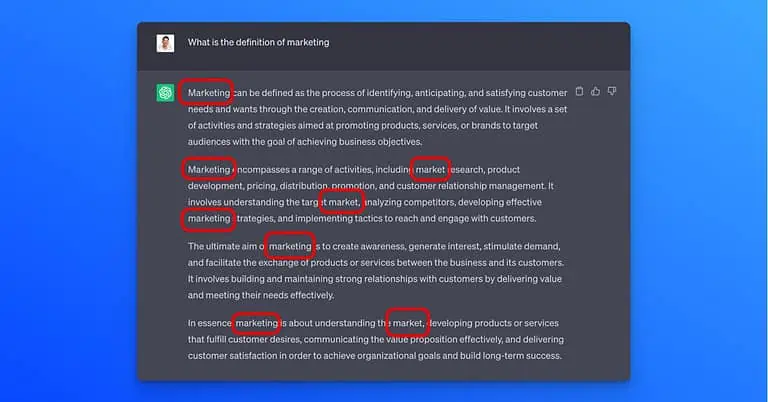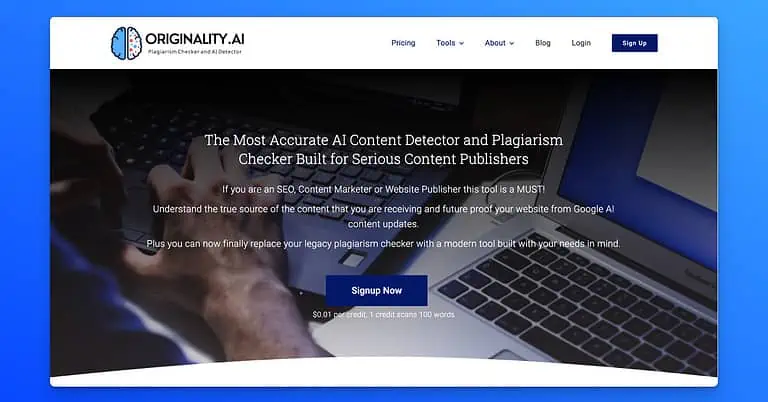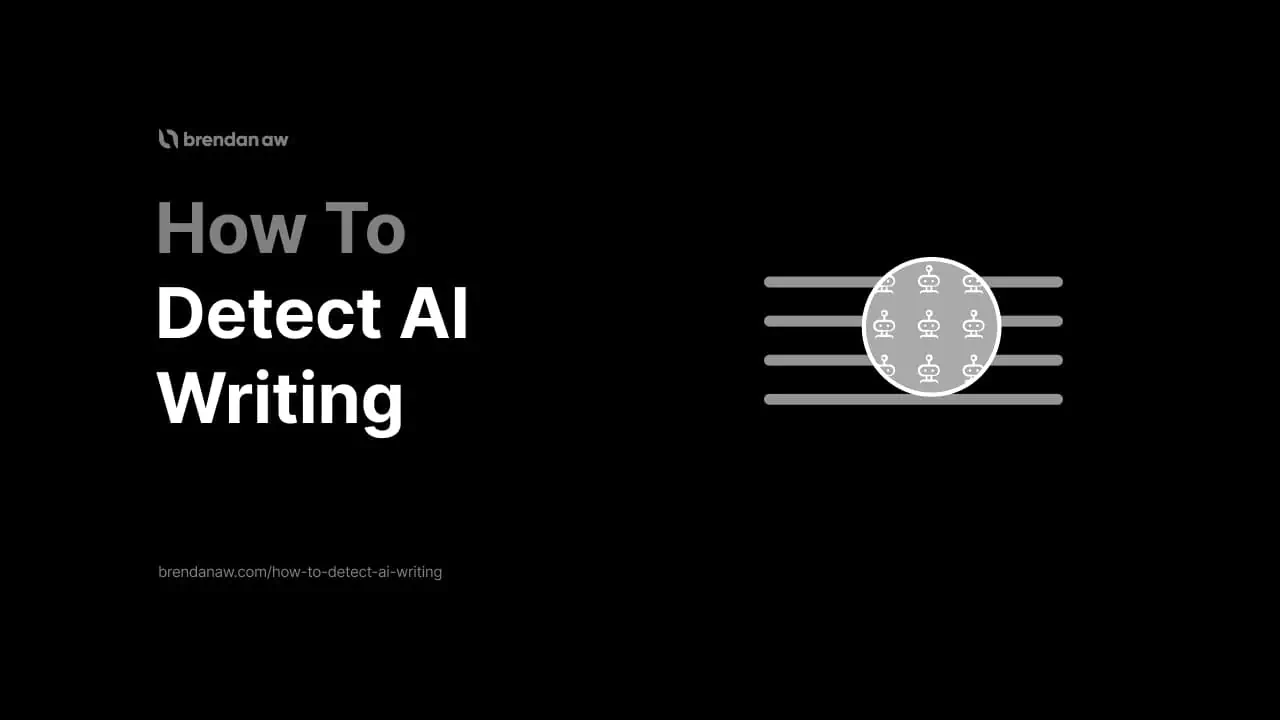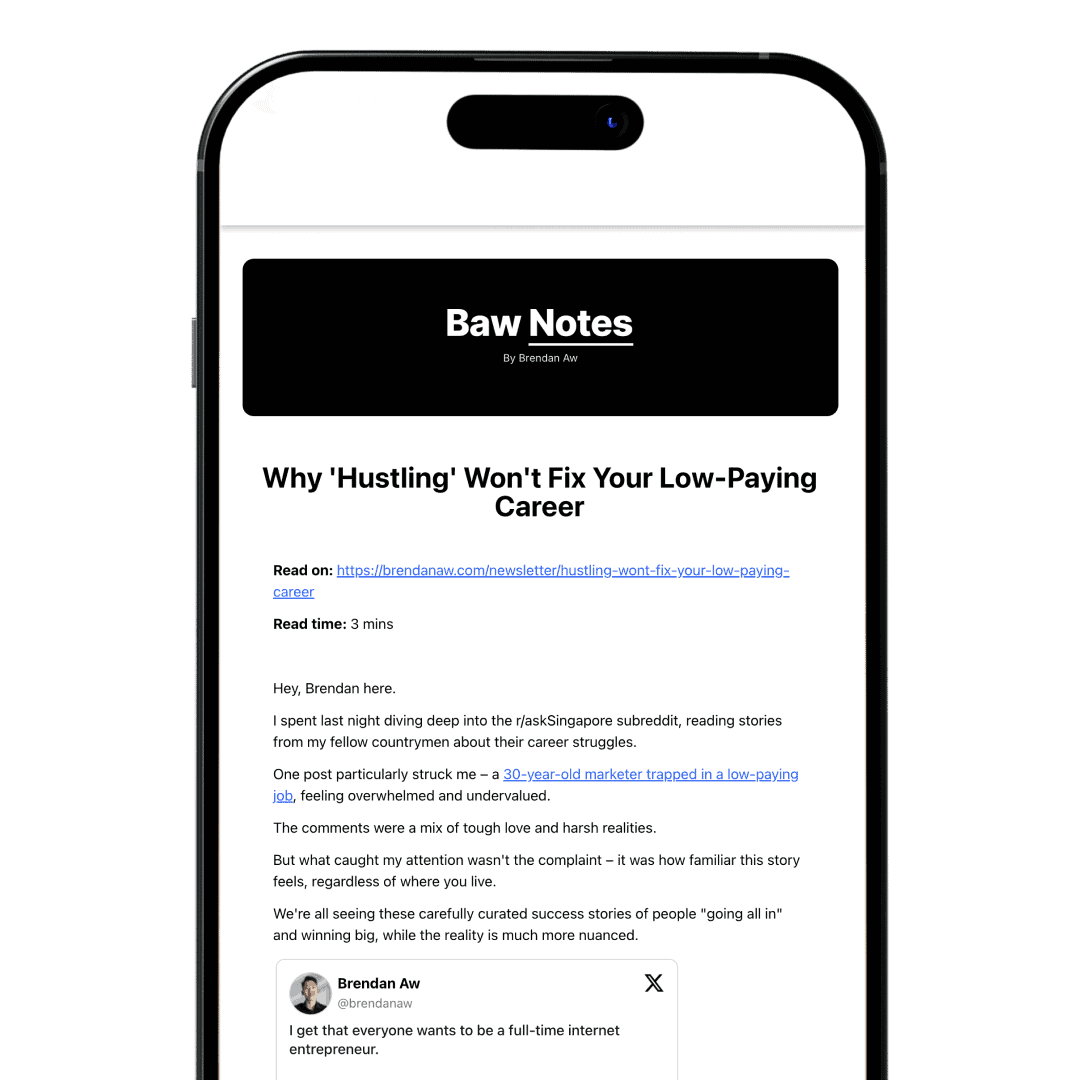Not Subscribed?
A weekly letter for solopreneurs building one-person businesses—using automation, systems, and smart workflows to grow without teams, burnout, or bloat.
Share this article
Have you ever felt doubtful about an article online and can’t help but wonder if it was written by a real person or a robot?
You’re not alone.
Fake news is everywhere, and AI writing software like ChatGPT is used to spread wrong information and manipulate opinions.
And if you are a creator, you damn well better protect your reputation.
Unfortunately, knowing whether a piece of writing is AI or human-made can be tricky for many people.
Because they’re THAT good.
But luckily, we have methods to detect AI writing, so we know exactly who’s a robot.
In this post, I’ll uncover the most effective methods on how to detect AI writing.
How To Detect if Something Was Written by AI
AI writing tools are cool, but no one wants to be outsmarted by a robot.
Here, I’ve summarized the surefire ways to detect AI-written content:
- Check the Author’s Credibility and Sources
- Check for Repeated Words or Phrases
- Check the Accuracy of the Information Presented
- Check the Content’s Sentence Composition
- Check for the Author’s Personal Opinions
- Check Any Uniformity in the Tone or Style
- Use AI Content Detection Tools
1. Check the Author’s Credibility and Sources
This method is probably the easiest to detect if something is written by AI.
So, here’s what you need to do.
Try to verify the author’s credibility and the cited sources used in the article.
They should present reliable facts to back up any information mentioned in the article instead of just questionable websites or fabricated details.
Otherwise, it’s pretty obvious that the author is bluffing by feeding you with machine-made texts.
2. Check for Repeated Words or Phrases
Have you ever been suspicious of a blog post that seemed to be filled with the same words or phrases over and over?
If so, then you might be reading an AI-generated article.
People tend to use prompts to include keywords or phrases to boost SEO, but they don’t realize the output tends to be repetitive or sometimes nonsensical.
Unfortunately, these robotic ramblings are enough to turn off your readers quickly.
While keyword stuffing may have worked years ago, now it just makes your content look spammy and written by an SEO who lied on their resume.
Content creators should avoid this at all costs, as quality still wins over quantity.
Check this example from ChatGPT when I asked, “What is the definition of marketing?“

Notice how often the word marketing or market appears in this short paragraph.
3. Check the Accuracy of the Information Presented
Do the facts of what you’ve just read seem questionable?
AI-generated articles are hardly accurate, and that’s because computer algorithms are not programmed to identify correct information.
Yea, I know they can scour the web for answers, but most plugins or scrapers tend only to show the top results.
But truth be told, not even the top results on Google are always factual.
Also, if an AI writer cannot generate all the required information, the model will make up an answer similar to its training data.
So if you notice that the facts don’t add up, congratulations, it’s probably AI.
4. Check the Content’s Sentence Composition
AI is undeniably great at mimicry.
It can copy a human’s writing style by simply learning the patterns.
But they are still far from mastering complex sentence composition and nuances, especially when explaining a technical concept.
If you’re an expert in a particular technical field, you can try reading a technical blog post composed by an AI writer.
You’ll surely find a lot of information that doesn’t seem to make sense and probably roll your eyes or puke in your mouth.
So be sure to investigate further if something is off before trusting the site you’ve visited.
5. Check for the Author’s Personal Opinions
If an article lacks the personal touch (or a human), then it is likely written by AI.
As I’ve mentioned, AI technology is best at collecting and manipulating data but doesn’t stand a chance when creating insightful and truly helpful content.
That’s also why I’m pretty sure that content writers won’t be replaced by AI just yet or ever.
Hence, AI is only suited for creating static content that may only include historical facts and figures without in-depth analysis whatsoever.
No doubt, tools like ChatGPT are getting better.
But for now, it is best to avoid sites that show you ‘robotic’ and low-quality content.
After reading this article up to this point, do you think an AI writer could speak for me?
Probably not.
This is me, Brendan, who is writing it with my own thoughts.
6. Check Any Uniformity in the Tone or Style
AI writing might look pretty legit at first glance.
But if you look closer, you can see a few signs that’ll help you recognize robot-made texts.
One of these is its uniform writing tone and style.
There’s no denying that AI is getting better at writing, but it can’t totally mimic a human writer’s natural tone and inconsistency.
Humans are not perfect, and neither is their writing.
Humans tend to have sudden changes in burstiness and perplexity from one paragraph to the next, but AI content is formed from chunks of information based on what it was trained on.
Note: Don’t be fooled by the typing animation that ChatGPT or another tool shows you, the output of the phrase or sentence has already been decided on the backend.
Remember, a human writer doesn’t always maintain a consistent tone throughout an article. There are going to be variations.
Whereas AI-generated content can sound “off” in certain areas because it still tries to be “consistent” even if the words don’t fit.
This can be hard to catch unless you’re attuned to it, but it can be a major red flag if you see one.
7. Use AI Content Detection Tools
As the saying goes, sometimes it takes a robot to catch another robot. This is where AI detectors shine the best.
But how does AI text detection work?
The best AI detection tools heavily rely on writing patterns and highlighting any text that is considered the work of a fellow machine.
For example, you can check an article using the AI Classifier, which uses OpenAI’s models to spot AI-generated text.
But remember, there are tons of other AI detector tools out there.
If you are curious, I highly recommend trying these popular tools:
Originality.ai

Check out Originality.ai if you’re on the hunt for an industry-leading content checker that can detect plagiarism and AI-generated writing. This tool is, by far, the best tool for accurately checking texts produced by ChatGPT and GPT-4.
Originality only costs 0.01 per 100 words, which is a pretty reasonable price for the quality of its service.
The AI detector also provides an account dashboard where all your scanned articles are saved. This feature helps you stay organized, especially if you want to revisit certain articles for review.
Another great tip: the longer text you provide, the more accurate the detection becomes.
Reliability doesn’t necessarily mean accuracy, so you shouldn’t rely on it completely.
Winston AI

Winston AI is a reliable AI tool that has gained the trust of content writers and educators due to its robust AI detection algorithm.
One of the features I love is the OCR (Optical Character Recognition) technology, which allows the software to scan texts on pictures or PDF documents.
So, any AI-generated texts hidden in images or PDFs will be less likely to escape the tool’s detection algorithm.
But that’s not all. It also comes with a plagiarism checker. This feature safeguards your content from unauthorized duplication and ensures the work remains original.
Once the algorithm has finished scanning the content, you will be presented with a human score, a plagiarism score, and a readability score.
GPTZero

GPTZero analyzes an article’s complexity and “burstiness” (a metric used to identify long and short sentences). These metrics are, by far, the strongest indicators of AI writing.
If you’re curious about GPTZero, try this AI tool for free.
What Is the Best Method to Detect AI-Generated Content?
There is no easy answer to finding the best method for detecting AI text.
Whether you’re a blogger or an educator, one method might work for you but not for the other.
But in my experience, the best way to detect AI writing is to use a combination of the abovementioned methods.
If you’re in academia and want to know if your students are using chatGPT to answer their assignments, then the fastest and best method would probably be using AI detection tools like Winston AI or Turnitin.
These are trained on more specific datasets.
But you’ll still need to use the other 6 methods to get a complete picture.
If you are a blogger, a more general tool like Originality.ai might be better.
Why Detecting AI Writing Is Important
The reasons are obvious, but let’s break them down one by one below:
1. To Know Whether Content Is Fake or Authentic
AI content can quickly spread fake news or sway public opinion.
We need to know the truthfulness of the information we’ve read and not just agree, or worse, spread the fake news, especially to the most vulnerable of the population.
Content credibility is important in building trust in media outlets and online platforms.
So before you trust any sites online, ensure that the content you’re consuming is real.
2. To Protect Intellectual Property
Genuine content should be a product of human creativity, unique perspectives, and personal experiences. AI technology doesn’t have these capabilities (as of this moment).
So if someone is creating content with tools like ChatGPT, this could spark concerns about plagiarism and copyright infringement.
The originality and uniqueness of human-written articles must be preserved.
Otherwise, there is no point in expressing creativity if everything is solely done by a machine.
After all, the purpose of writing is to communicate with other living beings.
3. To Maintain Ethical Standards
Let’s be real. Knowing if an article is created by a human or a robot can totally change our perception of the content. So, an AI-generated will most likely raise some ethical concerns.
For this reason, creators are obliged to disclose their writings that are assisted by AI. This will help build trust with their readers.
4. Preserve Human Connection
Unlike AI-generated articles, how we humans write is quite unique.
And that’s because our emotions, experiences, and empathy shines through in our writing.
Through AI content detection, we can watch for those fake articles and ensure our consumed content is genuine and relatable.
How About Watermarking AI-Generated Texts?
If you’re like me, you’ve probably wondered if watermarking can help with reliable AI writing detection.
Watermarking works by embedding identifiable characters like texts or symbols into the content so it’d be obvious that the AI made it. This could make sense – either there’s something there, or there isn’t – but we have to consider how it works when people start rewriting and whether those identifiers will stay put.
We must also determine what kind of info shows up in the watermark. Looking at things realistically here, an AI watermarking scheme doesn’t seem like much more than a band-aid solution to a big problem.
Overall, watermarking might only be helpful in the short term.
How to Detect AI Writing (FAQs)
Can AI Writing Be Detected?
Yes, AI writing can be detected using some AI tools available online. You can also use some of the methods discussed in this article.
To detect AI content, I would also recommend checking the content for unusual variations or inconsistencies in the tone or style of writing. AI algorithms are programmed to scour data on the web, so seeing sentences with strange phrases or patterns is not surprising.
If you know these signs, spotting an AI-generated text should be much easier.
How To Spot Content Written by AI?
AI content can be challenging to detect, but if you know the technology’s weakness, you can easily uncover it.
Here are a few tips to spot AI-written content. First, try to look out for sentence consistency and tone of writing. As mentioned in this post, AI often lacks human emotion or opinion, so anything that sounds robotic should give you a red flag.
Another tip is to challenge the AI tool with ambiguous questions. Remember that AI technology doesn’t have the capability to understand and respond naturally in the same way as we humans.
Of course, there are free tools out there, and feel free to use the ones recommended in this post.
But if you can identify these subtle signs, you should easily tell if the texts are written by a robot.
Does Google Detect AI Writing?
Though not officially confirmed, I believe the Google algorithm can automatically detect AI-generated content. But they have mentioned that manual action will be taken against content that looks ‘spammy’ and of low quality.
So, the answer can be a yes or a no.
Google promises to deliver the best experience to its users, so they’ve continuously improved its guidelines to eliminate junk content. Especially those filled with too many keywords or phrases to fool the search engine rankings.
So, in the end, it doesn’t matter whether the content is written by a human or a robot as long as it provides value. So for the most part, you don’t have to worry about being penalized by Google if you do it right.
How Can I Detect Essays Written by AI From My Students?
Many students think they could easily get away with cheating, thanks to AI tools like chatGPT. And this is a real struggle for all teachers.
So if you’re in academia, it’s only wise to teach yourself how to check if AI writes a paper.
On top of the techniques and tools mentioned in this post, it’s also helpful to familiarize yourself with your student’s typical writing style.
Any content that looks unusually advanced or inconsistent (based on their capabilities) should hint at where they got their assignments.
How To Use AI Without Plagiarizing?
Plagiarism simply means copy-pasting someone else’s work.
So, if the AI tool is providing you with texts from scratch using its algorithm, then you’re in the clear.
The tricky part is recognizing when an AI tool collects information from existing web pages (which most do) and generates articles that pass the plagiarism detectors.
This technique would probably be considered less than ethical.
So, you should know how your robot assistant works before trusting it completely.
To avoid plagiarism, the most obvious thing you can do is to create original content and not just copy from a source. If you are paraphrasing an idea, make sure to hyperlink this information to the original source.
Finally, don’t forget to use plagiarism checker tools – this will ensure that your written texts are original.
How Do I Make AI Content Undetectable?
One way to make AI content undetectable is to rewrite it. Try your best to use your own words and add additional insights you find valuable to the readers.
But, as mentioned, you should never forget to cite the original source or author. Plagiarism is a serious offense, and believe me, you don’t want to deal with that kind of mess.
If you’re using AI writing software, you can also instruct it to rewrite your text according to a particular style or tone.
However, it might not always give you the best results. AI can randomly change synonyms or replace some of your texts with phrases that would sound weird, and you don’t want that!
To Sum Up
If you’re unsure whether a robot or a human writes an article, use a combination of the above methods to spot AI-written text.
But I’d recommend using the AI detection tools above because of their convenience and accuracy.
And if you find any other methods that work well, let me know in the comments.
Alright, that’s a wrap.
Like this article?
Share this article

About the author
Hi, I’m Brendan Aw. A creator, GTM engineer, and digital entrepreneur obsessed with building lean businesses from home. Professionally, I’ve led marketing for 7–8 figure startups in e-commerce, fintech, e-sports, retail, agencies and Web3. I hold a B.Com in Accounting & Finance from UNSW and a Data Science certification from Le Wagon. Now, I document my entrepreneurship journey online for myself and others.
Here are more resources for you:
- Read Baw Notes: My weekly letter for those building lean, or one-person businesses using systems, automation, and digital leverage.
- Read my blog: Explore tactical guides on automation, systems, monetization, growth, and solo strategy.
- Use my online business tool stack: Discover the exact tools I use to run my businesses.
Not Subscribed?
A weekly letter for those building lean and one-person digital-first businesses.
Detect AI content with a stunning accuracy a 99%.

